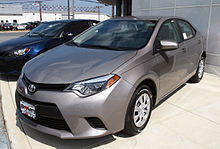Toyota Corolla
| Toyota Corolla | |
|---|---|
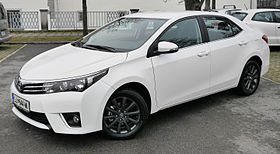 Toyota Corolla, international model | |
| Overview | |
| Manufacturer | Toyota Motor Corporation |
| Production | 1966–present |
| Body and chassis | |
| Class | Subcompact car (1966–1991) Compact car (1991–present) |
| Chronology | |
| Predecessor | Toyota Publica |
The Toyota Corolla is a line of subcompact and compact cars manufactured by Toyota. Introduced in 1966, the Corolla was the best-selling car worldwide by 1974[1] and has been one of the best-selling cars in the world since then. In 1997, the Corolla became the best selling nameplate in the world, surpassing the Volkswagen Beetle.[2] Toyota reached the milestone of 40 million Corollas sold over eleven generations in July 2013.[3] The series has undergone several major redesigns.
The name Corolla is part of Toyota's naming tradition of using names derived from the Toyota Crown for sedans. The Corolla has always been exclusive in Japan to Toyota Corolla Store locations, and manufactured in Japan with a twin, called the Toyota Sprinter until 2000. In Japan and much of the world, the hatchback companion since 2006 is called the Toyota Auris. Prior to the Auris, Toyota used the Corolla name on the hatchback bodystyle in various international markets.
Early models were mostly rear-wheel drive, while later models have been front-wheel drive. The Corolla's traditional competitors have been the Nissan Sunny, introduced the same year as the Corolla in Japan and the later Honda Civic. The Corolla's chassis designation code is "E", as described in Toyota's chassis and engine codes.
Contents
[hide]- 1Production locations
- 2Alternative versions
- 3First generation (E10; 1966–1970)
- 4Second generation (E20; 1970–1974)
- 5Third generation (E30, E40, E50, E60; 1974–1979)
- 6Fourth generation (E70; 1979–1983)
- 7Fifth generation (E80; 1983–1987)
- 8Sixth generation (E90; 1987–1991)
- 9Seventh generation (E100; 1991–1995)
- 10Eighth generation (E110; 1995–2000)
- 11Ninth generation (E120, E130; 2000–2006)
- 12Tenth generation
- 12.1Japan (E140 narrow; 2006–2012)
- 12.2International (E140/E150 wide; 2006–2013)
- 13Eleventh generation
- 13.1Japan (E160; 2012–present)
- 13.2International (E170; 2013–present)
Production locations[edit]
Corollas are manufactured in Japan at the original Toyota Takaoka location built in 1966. Various production facilities have been built in Brazil, (Indaiatuba, São Paulo), Canada (Cambridge, Ontario), China (Tianjin), India (Bangalore), Pakistan(Karachi), South Africa (Durban), Taiwan, Thailand, Vietnam, Turkey andVenezuela. Production has previously been made in Australia (Victoria) and the United Kingdom (Derbyshire). Production in the United States (at NUMMI inFremont, California) ended in March 2010.[4] Production resumed the following year after the Toyota Motor Manufacturing Mississippi plant was opened in November 2011 in Blue Springs, Mississippi.[5]
Alternative versions[edit]
In Japan, the Corolla has always been exclusive to Japanese retail sales chain called Toyota Corolla Store, which was previously established in 1961, calledToyota Public Store, selling the Toyota Publica. A badge engineered version called the Sprinter was introduced around the same time as the Corolla in Japan, and sold at a different Toyota Japan dealership sales channel called in 1966 Toyota Auto Store.
There have also been several models over the years, including the Corolla Ceres (and similar Sprinter Marino) hardtop, Corolla Levin and Sprinter Truenosports coupés and hatchbacks, and the Corolla FX hatchback, which became the Corolla RunX, while the Sprinter became the Allex, with the introduction of the ZZE128 Corolla. The RunX and Allex was replaced by the Auris in 2006 (known only as Corolla in markets outside Japan and South Africa). A luxury version of the Auris installed with V6 engines was briefly sold at Japanese Toyota dealerships Toyota Store and Toyopet Store locations as the Blade, which was discontinued in 2012.
A compact MPV named the Corolla Verso has also been released in European markets. Its Japanese counterpart is the Corolla Spacio, which has been discontinued as of the 10th generation. The Corolla Rumion is also sold in the US-market as the Scion xB.
The Corolla Matrix, better known just as the Matrix, shares the E120 and E140 platforms, and is considered the hatchback/sport wagon counterpart of the North American Corolla sedan, as the European/Australasian Corolla hatchback is not sold there. Toyota frequently combines the sales figures of the Corolla sedan and Matrix. The Pontiac Vibe, which is the General Motors badged version of the Matrix, also shares the Corolla platform. The Pontiac Vibe was exported from Fremont, California to the Japanese market where it was sold as the Toyota Voltz.[6]
Over many years, there have been rebadged versions of the Corolla, sold by General Motors, including the Holden Nova in Australia during the early 1990s, and the Sprinter-based Chevrolet Nova, Chevrolet Prizm, and Geo Prizm (in the United States). The Corolla liftback (TE72) of Toyota Australia was badged as simply the T-18. The five-door liftback was sold with the Corolla Seca name in Australia and the nameplate survived on successive five-door models.
The Daihatsu Charmant was produced with the E30 through E70 series.
The Tercel was a front wheel drive car, first introduced in 1980 at Japanese Toyota dealerships called Toyota Corolla Store, and was called the Corolla Tercelthen, and later given its own name in 1984. The Tercel platform was also used for the Corolla II hatchback in Japan.
First generation (E10; 1966–1970)[edit]
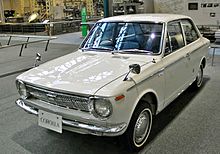
The first Corolla generation was introduced in October 1966 with the new 1100 cc K pushrod engine. The Corolla Sprinter was introduced as the fastback version in 1968, and exclusive to a Toyota Japan dealership retail outlet calledToyota Auto Store.
Second generation (E20; 1970–1974)[edit]
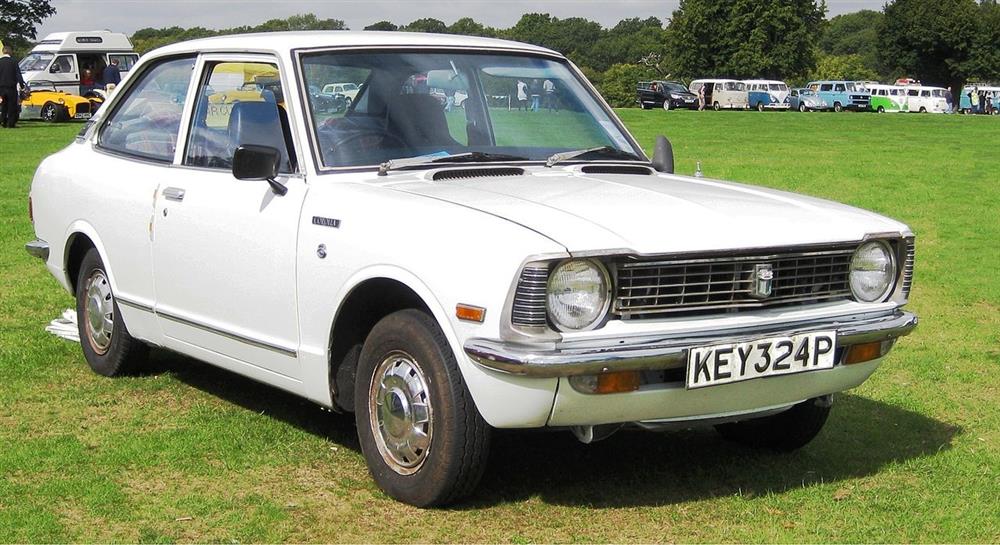
In May 1970, the E20 was restyled with a more rounded body and the 1400 cc T and 1600 cc 2T OHV engines were added to the range. The now mutually exclusive Corolla and Sprinter names were used to differentiate between two slightly different treatments of sheet metal and trim. The Corolla Levin and Sprinter Trueno names were introduced as the enhanced performance version of the Corolla and Sprinter respectively when a double overhead camshaft version of the 2T engine was introduced in March 1972 (TE27).
In Australia, only the 3K powered 2-door KE20 was available as a sedan and wagon / panelvan. The brakes were single system with no booster, solid discs on the front and rear drums. Front sway bar but no rear sway bar. Parts are not compatible with later models.
In NZ, the 4-door KE20 was available.
Most models stopped production in July 1974 but the KE26 wagon and van were still marketed in Japan alongside the new 30-series, until production finally ended in May 1978.
Third generation (E30, E40, E50, E60; 1974–1979)[edit]
_E30.jpg)
April 1974 brought rounder, bigger and heavier Corollas and Sprinters. The range was rounded out with the addition of a two-door liftback. The Corollas were given E30 codes while the Sprinters were given E40 codes. A face-lift in March 1976 saw most Corolla E30 models replaced by equivalent E50 models and most Sprinter E40 models were replaced by equivalent E60 models. The E30 Corolla was fitted with retracting front seat belts.
In Australia, KE3x was available as 4 door sedan, 2 door sedan, 2 door panel van (KE36) and 4 door wagon (KE38). All had 3K engines and K40 manual gearbox or 3 speed Auto. Sprinters were not available. Later KE5x models were available as 4 door sedan or 2 door coupe (A true pillar-less design) with 4K engine. The KE55 was 50 kg heavier due to the addition of side impact protection in the doors, but due to a change in the body metal and seam sealing they are prone to rust. Later KE55 also used plastic ended bumper bars as opposed to the all chrome bumpers of the previous models, but included a rear sway bar for the first time.
Fourth generation (E70; 1979–1983)[edit]

A major restyle in March 1979 brought a square edged design. The Corollas had a simpler treatment of the grill, headlights and taillights while the Sprinter used a slightly more complex, sculptured treatment. The new A series engines were added to the range as a running change. This was the last model to use the K "hicam" and T series engines. Fuel injection was introduced as an extra cost option on Japanese market vehicles.
Fifth generation (E80; 1983–1987)[edit]
_S_sedan_(2015-07-09)E80.jpg)
A sloping front bonnet and a contemporary sharp-edged, no-frills style was brought in during May 1983. The new 1839 cc 1C diesel engine was added to the range with the E80 Series. From 1985, re-badged E80 Sprinters were sold in the U.S. as the fifth-generation Chevrolet Nova. Fuel injection was introduced as an extra cost option internationally.
Most models now used the front wheel drive layout except the AE85 and AE86, which were to be the last Corollas offered in the rear wheel drive or FR layout. The AE85 and AE86 chassis codes were also used for the Sprinter(including the Sprinter Trueno). The Sprinter was nearly identical to the Corolla, differing only by minor body styling changes such as pop-up headlights.
Sixth generation (E90; 1987–1991)[edit]
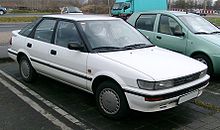
A somewhat more rounded and aerodynamic style was used for the E90 introduced in May 1987. Overall this generation has a more refined feel than older Corollas and other older subcompacts. Most models were now front wheel drive, along with a few 4WD All-Trac models. Many engines were used on a wide array of trim levels and models, ranging from the 1.3-liter 2E to the 165 horsepower (123 kW) supercharged 4A-GZE. The E90 Sprinter was also rebadged and sold as the Geo Prizm (US) or Holden Nova (Australia).
Seventh generation (E100; 1991–1995)[edit]
_CSi_sedan_(2011-06-15)_EE100.jpg)
In June 1991 Corollas received a redesign to be larger, heavier, and have the completely rounded, aerodynamic shape of the 1990s. In the United States, the somewhat larger Corolla was now in the compact class, rather than subcompact, and the coupé was still available in some markets, known as the AE101 Corolla Levin. Carburetors were mostly retired with this generation.
Eighth generation (E110; 1995–2000)[edit]
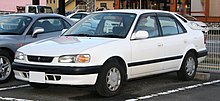
_Ascent_sedan_E110JAPAN.jpg)
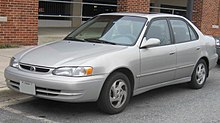
Production of the E110 Corolla started in May 1995. The design of the car was slightly altered throughout but retained a look similar to that of the E100. Evolutionary technological improvements continued,[citation needed] however, and in 1998, for the first time, some non-Japanese Corollas received the new 1ZZ-FE engine.[citation needed] The new engine was the first in a Toyota to have an aluminum engine block and aluminum cylinder heads, which made this generation lighter than the E100 Corolla. The model range began to change as Toyota decided styling differences would improve sales in different markets. This generation was delayed in North America until mid-1997 (US 1998 model year), where it had unique front and rear styling.[citation needed] Europe and Australasia received versions of their own as well. In Pakistan, this model was halted in November 1998, while production was closed in March 2002.
Ninth generation (E120, E130; 2000–2006)[edit]
_Conquest_sedan_E120JAPAN.jpg)
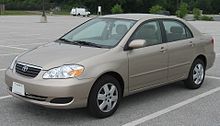
In August 2000, the ninth-generation Corolla was introduced in Japan, with edgier styling and more technology to bring the nameplate into the 21st century. In 2002, the Corolla was given a refreshed facelift and it grew in length with similar body panels and interior. The facelifted Corolla since then is called Corolla Altis in the ASEAN region. The station wagon model is called the Corolla Fielder in Japan. The North American release was delayed until March 2002 (for the 2003 model year).
Production in Asia continued until late 2006 but production in North America continued until October 2008.
Tenth generation[edit]

_E140PAK.jpg)
Japan (E140 narrow; 2006–2012)[edit]
The tenth generation of the E140 Corolla was introduced in October 2006. Japanese markets called the sedan Corolla Axio. The station wagon retained the Corolla Fielder name.
International (E140/E150 wide; 2006–2013)[edit]
For international markets, a wider version of the E140 was sold with different styling, with the ASEAN markets retaining the Corolla Altis branding.
Eleventh generation[edit]
_E160.jpg)
Japan (E160; 2012–present)[edit]
The eleventh generation of the Corolla went on sale in Japan in May 2012.[7] The sedan is named the Corolla Axiowhile the wagon is called the Corolla Fielder. In Japan, both are made by a Toyota subsidiary, Central Motors, in Miyagi prefecture, Japan.[8] The redesigned model has slightly smaller exterior dimensions and is easier to drive in narrow alleys and parking lots for the targeted elderly consumers.[9]
The new Corolla Axio is available with either a 1.3-liter 1NR-FE or 1.5-liter 1NZ-FE four cylinder engines; front or all-wheel drive. Both 5-speed manual and CVT transmissions are offered. The 1.3-liter engine and all-wheel drive variants are available only with the CVT transmission.[10] The Corolla Fielder is available with 1.5-liter 1NZ-FE or 1.8-liter 2ZR-FAEfour cylinder engines mated with a CVT transmission. The 1.5-liter is available with front and all-wheel drive, the 1.8-liter is offered only in front-wheel drive.[11]
Toyota released hybrid versions of the Corolla Axio sedan and Corolla Fielder station wagon for the Japanese market in August 2013. Both cars are equipped with a 1.5-liter hybrid system similar to the one used in the Toyota Prius c, with a fuel efficiency of 3.03 L/100 km (93.2 mpg-imp; 77.6 mpg-US) under the JC08 test cycle. Toyota's monthly sales target for Japan is 1,000 units of the Corolla Axio hybrid and 1,500 units of the Corolla Fielder hybrid.[12]
International (E170; 2013–present)[edit]

International markets continued on with the E140/E150 until at least 2013 when the E170 model arrived. The E170 is larger and substantially different from the Japanese E160, with a unique body and interior. Two basic front and rear styling treatments are fitted to the E170—a North American version that debuted first—and a more conservative design for all other markets that debuted later in 2013.
|
|
Alternative versions
Using the Corolla chassis

A slightly upmarket version called the Sprinter was sold in the Japanese home market. It was replaced in 2001 by the Allex, which was then replaced by the Blade in 2009.
There have also been several models over the years, including the Corolla Ceres (and similar Sprinter Marino) hardtop, Corolla Levin and Sprinter Trueno sports coupés and hatchbacks, and the Corolla FX hatchback, which became the Corolla RunX, while the Sprinter became the Allex with the introduction of the ZZE128 Corolla. The RunX and Allex was replaced by the Auris in 2006 (known only as Corolla in markets outside of Japan). Acompact MPV named the Corolla Verso has also been released in European markets. Its Japanese counterpart is the Corolla Spacio, which has been discontinued as of the 10th generation. The Corolla Rumion is also sold in the US-market as the Scion xB.
The Corolla Matrix, better known just as the Matrix, shares the E120 and E140 platforms, and is considered the hatchback/sport wagon counterpart of the North American Corolla sedan, as the European/Australasian Corolla hatchback is not sold there. Toyota frequently combines the sales figures of the Corolla sedan and Matrix. The Pontiac Vibe, which is the General Motors badged version of the Matrix, also shares the Corolla platform. The Pontiac Vibe was exported from Fremont, California to the Japanese market where it was badged Toyota Voltz. [5]
Over the years, there have been rebadged versions of the Corolla, sold by General Motors, including the 1980s' Holden Nova of Australia, and the Sprinter-basedChevrolet Nova, Chevrolet Prizm, and Geo Prizm (in the United States). The Corolla liftback (TE72) of Toyota Australia was badged as simply the T-18. The five-door liftback was sold with the Corolla Seca name in Australia and the nameplate survived on successive five-door models.
The Daihatsu Charmant was produced with the E30 through E70 series.
Using the Corolla name
The Tercel was a front wheel drive car, first introduced in 1980 and was called theCorolla Tercel then, and later given its own name in 1984.
The Tercel chassis was also used for the Corolla II hatchback in Japan.
History
First generation (E10)

The first Corolla generation was introduced in October 1966 with the new 1100 cc K pushrodengine. The Corolla Sprinter was introduced as the fastback version in 1968.
Second generation (E20)

In May 1970, the E20 was restyled with a more rounded body and the 1400 cc T and 1600 cc 2TOHV engines were added to the range. The now mutually exclusive Corolla and Sprinter names were used to differentiate between two slightly different treatments of sheet metal and trim. The Corolla Levin and Sprinter Trueno names were introduced as the twin-cam version of the Corolla and Sprinter respectively.
Third generation (E30, E40, E50, E60)
_E30.jpg)
April 1974 brought rounder, bigger and heavier Corollas and Sprinters. The range was rounded out with the addition of a two-door liftback. The Corollas were given E30 codes while the Sprinters were given E40 codes. A face-lift in March 1976 saw most Corolla E30 models replaced by equivalent E50 models and most Sprinter E40 models were replaced by equivalent E60 models.
Fourth generation (E70)

A major restyle in March 1979 brought a square edged design. The Corollas had a simpler treatment of the grill, headlights and taillights while the Sprinter used a slightly more complex, sculptured treatment. The new A series engines were added to the range as a running change. This was the last model to use the K "hicam" and T series engines.
Fifth generation (E80)
_S_sedan_(2015-07-09)E80.jpg)
A sloping front bonnet and a contemporary sharp-edged, no-frills style was brought in during May 1983. The new 1839 cc 1C diesel engine was added to the range with the E80 Series. From 1985, re-badged E80 Corollas were sold in the U.S. as the fifth generation Chevrolet Nova.
Most models now used the front wheel drive layout except the AE85 and AE86, which were to be the last Corollas offered in the rear wheel drive or FR layout. The AE85 and AE86 chassis codes were also used for the Sprinter(including the Sprinter Trueno). The Sprinter was nearly identical to the Corolla, differing only by minor body styling changes such as pop-up headlights.
Sixth generation (E90)

A somewhat more rounded and aerodynamic style was used for the E90 introduced in May 1987. Overall this generation has a more refined feel than older Corollas and other older subcompacts. Most models were now front wheel drive, along with a few 4WD All-Trac models. Many engines were used on a wide array of trim levels and models, ranging from the 1.3 liter 2E to the 165 horsepower (123 kW) supercharged 4A-GZE. The E90 Corolla was also rebadged and sold as the Geo Prizm (US) or Holden Nova (Australia).
Seventh generation (E100)
_CSi_sedan_(2011-06-15)_EE100.jpg)
In June 1991 Corollas received a redesign to be larger, heavier, and have the completely rounded, aerodynamic shape of the 1990s. The Corolla was now in the compact class, rather than subcompact, and the coupe still available known as Corolla Levin AE101. Refinement reached new levels, as development chief Dr. Akihiko Saito strove to create a "mini-Lexus"[citation needed].
Eighth generation (E110)

May 1995 saw a complete redesign for the Corolla. External differences from the E100 series were obvious. Evolutionary technological improvements continued, however, and in 1998, for the first time, some non-Japanese Corollas received the new 1ZZ-FE engine. The new engine was the first in a Toyota to have an aluminum engine block and aluminum cylinder heads, which made this generation lighter than the E100 Corolla. The model range began to change as Toyota decided styling differences would improve sales in different markets. This generation was delayed in North America until mid 1997 (US 1998 model year), where it had unique front and rear styling. Europe and Australasia received versions of their own as well.
Ninth generation (E120, E130)

In November 2000, the ninth-generation Corolla was introduced in Japan, with edgier styling and more technology to bring the nameplate into the 21st century. It is also called the Corolla Altis in theASEAN region. The station wagon model is called the (Japanese: Corolla Fielder) in Japan. The North American release was delayed until March 2002 (2003 MY).
Tenth generation (E140, E150)
_E140PAK.jpg)
The tenth generation of the Corolla was introduced in October 2006. Japanese markets called it the Corolla Axio, with the ASEAN markets retaining the Altis branding. The station wagon retains theCorolla Fielder name. The Corolla Altis and Corolla Axio have a different appearance.[6] The North American release was delayed until January 2008 (2009 MY).
Eleventh generation[edit]
_E160.jpg)
Japan (E160; 2012–present)[edit]
The eleventh generation of the Corolla went on sale in Japan in May 2012.[7] The sedan is named the Corolla Axiowhile the wagon is called the Corolla Fielder. In Japan, both are made by a Toyota subsidiary, Central Motors, in Miyagi prefecture, Japan.[8] The redesigned model has slightly smaller exterior dimensions and is easier to drive in narrow alleys and parking lots for the targeted elderly consumers.[9]
The new Corolla Axio is available with either a 1.3-liter 1NR-FE or 1.5-liter 1NZ-FE four cylinder engines; front or all-wheel drive. Both 5-speed manual and CVT transmissions are offered. The 1.3-liter engine and all-wheel drive variants are available only with the CVT transmission.[10] The Corolla Fielder is available with 1.5-liter 1NZ-FE or 1.8-liter 2ZR-FAEfour cylinder engines mated with a CVT transmission. The 1.5-liter is available with front and all-wheel drive, the 1.8-liter is offered only in front-wheel drive.[11]
Toyota released hybrid versions of the Corolla Axio sedan and Corolla Fielder station wagon for the Japanese market in August 2013. Both cars are equipped with a 1.5-liter hybrid system similar to the one used in the Toyota Prius c, with a fuel efficiency of 3.03 L/100 km (93.2 mpg-imp; 77.6 mpg-US) under the JC08 test cycle. Toyota's monthly sales target for Japan is 1,000 units of the Corolla Axio hybrid and 1,500 units of the Corolla Fielder hybrid.[12]
International (E170; 2013–present)[edit]

International markets continued on with the E140/E150 until at least 2013 when the E170 model arrived. The E170 is larger and substantially different from the Japanese E160, with a unique body and interior. Two basic front and rear styling treatments are fitted to the E170—a North American version that debuted first—and a more conservative design for all other markets that debuted later in 2013.
|
Safety
In Australia, Corolla models built between 1986 and 2006 were assessed in the Used Car Safety Ratings 2008:[7]
- (1986–1988) — worse than average
- (1989–1993) — average
- (1994–1997) — better than average
- (1998–2001) — better than average
- (2002–2006) — better than average
The US Insurance Institute for Highway Safety rated the 1998-2002 models as "Acceptable" in their 40 mph (64 km/h) frontal offset crash test. Initial 2003 models had an overall "Good" rating, but received a "Marginal" on left foot injury protection. A rebuild beginning December 2002, which continues through to the 2008 model, gives the Corolla a "Good" rating in all aspects of the test. Corolla models from model year 2005 to 2008 with optional side curtain air bags received an "Acceptable" rating in the side impact crash test, largely due to a "Marginal" rating in structure/safety cage design. Otherwise, injury protection ratings for driver and rear passenger were all good except for driver pelvis/leg injury protection, which was "Acceptable". The Corolla from model year 2009 to present with standard side curtain air bags received a "Good" rating in both the frontal offset and side impact crash test.[8]
Euro NCAP ratings are as follows:
- 1998 (EE110 1.3 5-door liftback LHD): 3 stars (23 points) adult occupant, 2 stars (15 points) pedestrian (pre-2002 rating system)
- 2002 (ZZE120 1.4 5-door hatchback RHD): 4 stars (28 points) adult occupant, 2 stars (11 points) pedestrian
- 2007 (E150 4-door sedan): 5 stars (34 points) adult occupant, 4 stars (39 points) child occupant, 3 stars (23 points) pedestrian

